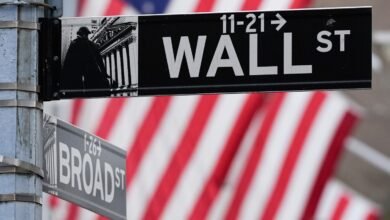Tech Giants’ Stocks Experience a “Sell the Fact” Reaction

The Mag 7 index fell by 0.66%, ending a four-day rally. Analysts believe that the market’s strong expectation of interest rate cuts had previously pushed the U.S. stock market to record highs. After a significant surge, tech stocks with high valuations are due for a breather, and some of the trading in growth stocks reflects a ‘sell the fact’ dynamic.
After the Federal Reserve finally delivered the long-anticipated rate cut, Wall Street did not indulge in jubilation but instead witnessed a classic ‘sell-the-fact’ trading pattern. Capital flowed out of high-valuation tech stocks and into traditional sectors such as finance and utilities that benefit from interest rate cuts.
According to Wall Street Wisdom, the Federal Reserve cut rates by 25 basis points as expected on Thursday, emphasizing downside risks to employment and projecting two more rate cuts this year. The Nasdaq 100 Index, dominated by technology stocks, fell by 0.2%, with the technology sector being the worst performer. The Mag 7 index declined by 0.66%, ending a four-day winning streak.
During the subsequent press conference, Federal Reserve Chair Jerome Powell highlighted that inflation risks had “risen slightly” and described this move as a ‘risk management’ rate cut. These remarks further exacerbated the sell-off in technology stocks, with the Mag 7 underperforming the remaining 493 components of the S&P 500 Index on the day.
(Buying support after Powell stopped speaking narrowed the decline in the Mag 7 index.)
Mag 7 experiences ‘sell-the-fact’ trading
This pullback in technology stocks is widely seen as a correction to the massive gains accumulated earlier.
Ivan Feinseth, Chief Investment Officer at Tigress Financial Partners, stated:
For growth stocks, some of the trading falls into the category of ‘sell-the-fact,’ as the strong market expectations for rate cuts had already pushed the U.S. stock market to record highs.
Data shows that since early April, the basket of ‘Mag 7’ stocks, including NVIDIA and Alphabet, has surged nearly 60%, with their forward price-to-earnings ratio climbing from nearly 22x to 30x. Ivan Feinseth added:
After a sharp rise, high-valued technology stocks are due for a breather. Moreover, there remains significant uncertainty regarding how tariffs will impact the economy.
Apart from the ‘sell-the-fact’ trading, the increase in U.S. Treasury yields has partly weighed on the share prices of tech giants.
U.S. Treasury yields briefly fell after the Fed statement but reversed intraday losses following Jerome Powell’s remarks, surging rapidly. In the end, the 10-year yield increased by 6.3 basis points, while the 2-year yield rose by 5.62 basis points.
(Comparison chart of major U.S. Treasury maturity yields)
Theoretically, technology companies are particularly vulnerable to the impact of rising U.S. Treasury yields because their valuations are largely based on profit expectations over many years, and higher yields reduce the present value of those future earnings.
Notably, there was a divergence within the technology sector.
Interest-rate-sensitive tech stocks such as NVIDIA, Amazon, and Broadcom all closed lower, whereas Apple and Microsoft, traditionally viewed as safe-haven assets due to their robust business models and strong cash generation capabilities, rose.
Traditional sectors benefit from rate cut expectations.
When technology stocks came under pressure, funds clearly flowed into sectors that could directly benefit from falling interest rates.
The financials, consumer staples, and utilities sectors became the best-performing groups in the S&P 500 Index on that day. These sectors typically offer substantial dividends, making them attractive to income-oriented investors in a rate-cutting environment.
The banking sector performed particularly well. The KBW Bank Index rose by 1.3%, with its components including JPMorgan, Bank of America, and Citigroup. Lower interest rates are expected to stimulate loan demand while reducing banks’ deposit costs.
Other corners of the market also reflected this shift in risk appetite. The Russell 2000 small-cap index once surged by 2.1% and eventually closed up 0.2%. A basket of unprofitable tech companies tracked by Goldman Sachs rose by 1.9%.
John Cunnison, Chief Investment Officer of Baker Boyer Bank, stated that lower interest rates would support riskier companies in the stock market, especially small-cap stocks and unprofitable tech firms. However, he also cautioned:
While a deep recession appears unlikely, the current valuations of growth stocks and large tech companies seem excessively high after a significant rally.
Despite the market rotation, there was no sense of panic. The Cboe Volatility Index (VIX), known as Wall Street’s ‘fear gauge,’ fell below 16, far lower than the typical level of 20 seen during periods of market stress.
On Wednesday, the S&P 500 Index fell only 0.1% on the day, marking one of the least volatile Federal Reserve decision days in at least two years. Looking ahead, John Cunnison believes:
The bigger question for traders now is what all this implies for future rate cuts and the direction of the economy.
编辑/wendey
Credit: Source link






